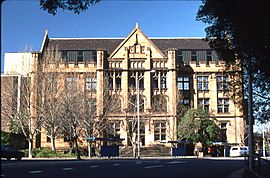Registrar-General's building facts for kids
Quick facts for kids Registrar-General's building |
|
|---|---|

The building, pictured in 2007
|
|
| Alternative names | Land Titles Office |
| Etymology | Registrar-General Department |
| General information | |
| Status | Complete |
| Type | Government administration |
| Architectural style | Federation Gothic |
| Location | 1 Prince Albert Road, Sydney central business district, New South Wales |
| Country | Australia |
| Coordinates | 33°52′12″S 151°12′48″E / 33.8699°S 151.2132°E |
| Current tenants | Land and Property Information |
| Construction started | 1909 |
| Completed | 1913 |
| Client | Registrar-General's Department |
| Owner | Government of New South Wales |
| Technical details | |
| Material |
|
| Floor count | 3 |
| Design and construction | |
| Architect |
|
| Architecture firm | New South Wales Government Architect |
| Official name | Land Titles Office; Registrar General's Department Building |
| Type | State heritage (built) |
| Designated | 2 April 1999 |
| Reference no. | 962 |
| Type | Administration Office |
| Category | Government and Administration |
| Builders | Loveridge & Hudson |
The Registrar-General's building, also known as the Land Titles Office, is a special building in Sydney, Australia. It is listed on the heritage list, meaning it's an important historical place. You can find it in the heart of Sydney central business district.
This building is used by the Land and Property Information group. This group is part of the Government of New South Wales. The building was added to the New South Wales State Heritage Register on 2 April 1999.
It is located near some other famous Sydney landmarks. These include St Mary's Cathedral, Queen's Square, St James' Church, and the Hyde Park Barracks. The Hyde Park Barracks is even a UNESCO World Heritage Site!
Contents
Building's Story
The main part of the Registrar-General's building was designed by Government Architect Walter Liberty Vernon. It was finished around 1913. The companies that built it and worked with the stone were Loveridge and Hudson.
Vernon designed the building in 1908. Construction started in 1909 and finished in 1913. It was built to be the new home for the Registrar-General's Department. This department used to be in a different office built in 1860. For most of the 1900s, this building was the main place to record important events. These included births, deaths, and marriages across the state. It also stored important documents about land ownership.
What the Building Looks Like
This building has three floors, plus an attic and a basement. It is made with a steel frame and has floors of strong concrete. The roof is covered with slate tiles.
The outside of the building is covered in sandstone. It has beautiful and detailed Gothic designs around the windows. You can also see lovely carvings on the gables (the triangular parts of the roof) and above the entrances.
The three large gables facing Prince Albert Road have cool, castle-like towers next to them. The side facing Queen's Square has a smaller gable with two towers on each side.
You can find some interesting initials carved into the stone. For example, "CH" (for Colin Hudson, a stonemason) is carved on one part of the wall. Nearby, you might spot "HCH" (for Herbert Charles Hudson, his father) on a small tower. On the main entrance arch, you can see the numbers "1912" carved together.
Changes Over Time
The building was first shaped like the letter "U". In the 1930s, the open north side was closed off with a new section. More additions were made in the 1960s to make the building even bigger.
Why This Building is Special
The Registrar-General's building is a very important civic building. It was designed to fit in well with older buildings nearby, like St. Mary's Cathedral. Its carefully designed sandstone front adds beauty to the street. It also helps connect the historical buildings along College Street to Queen's Square.
This building has a long history with important government tasks. It was where births, deaths, and marriages were officially recorded. It also stored records for things like trademarks and business sales. Most importantly, it keeps many valuable old records and land ownership documents safe.
Because of its history and design, the Registrar-General's building was added to the New South Wales State Heritage Register on 2 April 1999.
Images for kids
-
The building as viewed from Hyde Park




